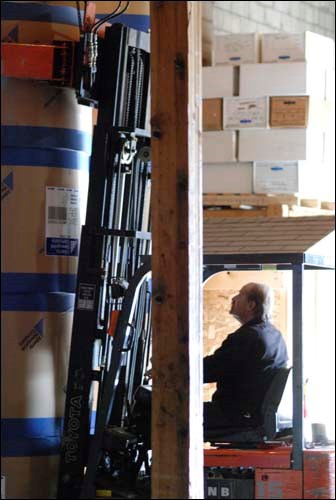You're holding it in your hands, but you probably don't know much about what went into making this newspaper.
First, let's start with the press. The press gets its name from the practice of carving wooden blocks, rolling them with ink, then pressing them onto paper. This method of reproducing both drawings and writing is thought to have originated in China, as early as the 9th century.
In the Western world, however, reading materials were still reproduced by monks, who painstakingly copied page after page of books by hand. Incidentally, this gave the Catholic Church much control over what was circulated.
Gutenberg changed all this when he invented movable type; letter blocks which could be arranged on a larger block that held 42 lines. Gutenberg's press, circa 1439, revolutionized the world, as it facilitated the spread of knowledge to people.
Fast forward to today, and the press has evolved substantially.
Here at Battlefords Publishing, we use a six-unit Goss Community Press. The machine can handle 32 tabloid pages (tabloid is the size of the Regional Optimist, the Star Phoenix is broadsheet) at a speed of 16,000 copies per hour.
The press was installed in the early 1970s. At the time, Battlefords Publishing's current location was home to Turner-Warwick Printers, who merged with McIntosh Publishing in 1995 to form Battlefords Publishing.
Gary Wappel, pressroom manager, started working for McIntosh Publishing in 1972. He remembers printing flyers for Mighty Mart and Kresge's, later known as K-Mart.
Today, Wappel said the pressroom uses an average of 25 rolls of paper per week. Each roll weighs nearly one thousand pounds and will produce 18,000 8-page copies.
Newspapers printed by Battlefords Publishing include the Regional Optimist, the News Optimist, the Wilkie Press, the Northwest Herald (Unity), the Independent (Biggar) and special publications such as the community directory.
Recently, 15 newspapers have been added to the lineup of printed materials at Battlefords Publishing Limited. These 15 newspapers were previously printed by Estevan Web Printing, but the company recently secured a contract for printing the Manitoba and Saskatchewan edition of the Globe and Mail.
"This month has been unreal," said Wappel of the transition.
This isn't the only recent development at Battlefords Publishing. In April of this year, a new data-entry and accounting system called DTI was brought in, which enabled the centralization of classifieds data entry and billing.
Before April, the classifieds department handled classifieds and ad billing for only the News-Optimist, the Regional Optimist and special publications such as the Farmer-Rancher.
Since then, 13 additional newspapers have been added to the list, and that number will increase to between 30 and 40 by next spring.
Publisher Alana Schweitzer said the increase in productivity, both in terms of DTI and the additional printing jobs, has been rewarding.
"It's been a challenge," she said. "But we're always up for challenges here."
Another recent change includes a new plate machine. The machine uses a laser to burn the images to be printed (both pictures and words) onto an aluminum sheet called a lithoplate.
The previous machine used chemicals and bright lights.
"Now it's chemical-free, which is safer for everybody," said Wappel.
The lithoplates are wrapped around a cylinder on the press machine. The cylinders are wet with water and then oil-based ink. The image burnt into the lithoplate picks up the ink and, since oil and water don't mix, the water keeps the ink off the rest of the plate.
For colour pages, four lithoplates are made: one for cyan ink, one for magenta ink, one for yellow ink and one for black.
Each plate roller transfers the image to a rubber blanket roller, which in turn transfers the image onto the paper, which is where the term offset printing comes from, since the lithoplate doesn't touch the paper.
Wappel has to check the copies, which are folded and cut by the machine, to make sure all the colours line up.
Since the aluminum plates can't be re-used, they are recycled, often being used as aluminum siding.
Before a lithoplate is made, though, someone has to decide what goes on the page.
It all starts with salespeople, who sell ads to businesses and other clients.
These clients discuss with the salespeople what information they want in their ads and what they want them to look like.
In collaboration with the clients and salespeople, graphic designers design the ads using Adobe InDesign.
Based on how many ads, which come in a variety of sizes, are sold, the production manager, Claude Paradis, decides how many pages the newspaper will be. Paradis also places the ads and the classifieds, which are entered by the DTI team, onto the pages.
Then the pages are handed over, albeit electronically, to the news team, who fill the spaces with photographs and informative and riveting news pieces. (Everything I write is riveting, right?)
Although the News Optimist and Regional Optimist are laid out by our news team, a layout team, which includes former reporter Jayne Foster, lay out the pages for eight surrounding area newspapers. By the time this story goes to press, three more newspapers will have been added to their workload.
Each of the pages are then sent back to their respective newspaper offices to be proofread, while each page of the News Optimist and Regional Optimist is proofread for mistakes by three people.
Once all the errors, including things like the text being too close to a headline, the photo credits not being italicized and general spelling misteaks (ha ha) are fixed, the pages are output to the lithoplate machine.
The plates are burnt, the paper run through the press machine, the insertion team sticks the sections and flyers together, the delivery driver drops it off at your door and voila!




